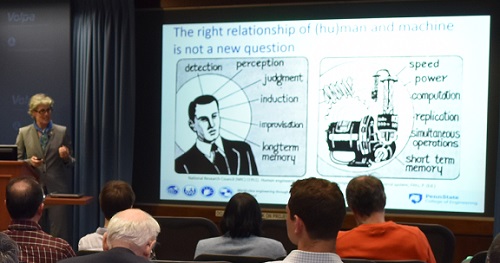Rethinking the Human-Autonomy Architecture
When people and computers interact, it’s usually a given that the computer serves as an aide while the human acts as a supervisor. Take the example of an airplane flying at 30,000 feet. The airplane may be on autopilot, but the human pilot is ready to take over if air traffic control needs a quick right turn.
With automation appearing more and more across daily life—including in air and ground travel—that division of labor could soon shift. Tasks we think of as belonging to humans may soon be taken over by computers, and there could be consequences to that shift that haven’t yet been imagined.
“The toaster was once automation—these days we call it an appliance,” said Amy Pritchett, professor and head of the Department of Aerospace Engineering at Pennsylvania State University, who spoke as part of Volpe’s 2017 speaker series, The Ongoing Transformation of the Global Transportation System. “These days, automation is a moving target because it goes with our presumption of what is ascribed to the human. And we have a different vision of what the human does. Machines have caught up with that vision, and now we’re at a very interesting time in ground transportation and in aviation.”
Watch video highlights of Amy Pritchett's talk at Volpe.
How Automation Can Introduce Complexity
Automation can take specific tasks out of human hands, but automation can also make it more complex and more difficult for a human to act as supervisor, Pritchett said.
During an average flight, a human pilot is manually flying for just two to seven minutes, Pritchett said.
The rest of the time? Pilots are managing. They are watching outside, talking with air traffic control, and communicating with personnel from their airline, all while being on-call for those two to seven minutes.
“As the technology becomes more advanced, human tasks are becoming rare and more difficult,” Pritchett said. “It’s one thing to supervise an autopilot when you’re familiar with hand-flying yourself. But as the systems become more powerful, the amount that you are doing the task—instead of being the manager—goes down. You get pushed further from the core work of flying the vehicle. With that, you’re getting pushed out of the cockpit. But you still have to recognize when to step in.”
A Shifting Paradigm of Human-Autonomy Interaction
As vehicles of all kinds gain automation, the traditional architecture of how humans and computers interact may get muddy, Pritchett said. Are humans still expected to be supervisors? As we near full automation, does the ultimate responsibility for what happens in an airplane or a car still lie with the human operator?
In ground transportation, for example, there are five levels of automation. At level 4, where the driver is mostly not driving but could still have to take over during an emergency, Pritchett wonders if the driver’s operational skills will be up to the task of performing an emergency maneuver.
“I know that often, particularly in human factors or cognitive engineering domains, we’ve accepted the architecture and then we’ve quibbled over the interface, the training, and the procedures,” Pritchett said. “What I’d like to do is say, ‘Is this the right overall structure?’”

Capturing the Magic of Human Communication
The secret to a new human-autonomy architecture, at least for air travel, may lie in how commercial pilots interact with each other, Pritchett said. Flight crews often have a seamless, in-the-moment understanding of what needs to happen between two human pilots and the computer helping them fly the airplane.
“There’s something about a two-crew operation, when the communication and coordination is working well, that I believe is magic,” Pritchett said. “Magic means we don’t understand it yet, and yet if we really want to try to automate, if we really want to try to bring in more machine function—especially machine function to the point of replacing one or both of the flight crew—then this magic is something that we do need to be able to understand, and to be able to replicate.”
